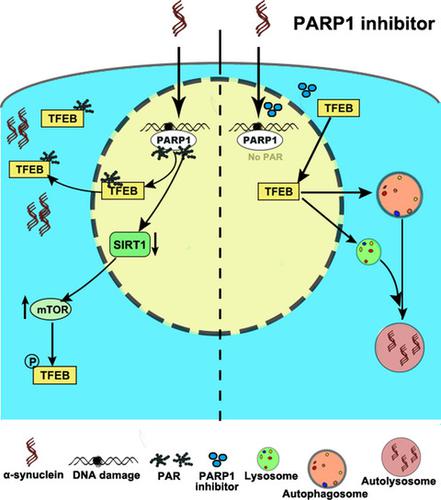当前位置:
X-MOL 学术
›
Aging Cell
›
论文详情
Our official English website, www.x-mol.net, welcomes your
feedback! (Note: you will need to create a separate account there.)
Poly (ADP-ribose) polymerase 1 inhibition prevents neurodegeneration and promotes α-synuclein degradation via transcription factor EB-dependent autophagy in mutant α-synucleinA53T model of Parkinson's disease.
Aging Cell ( IF 8.0 ) Pub Date : 2020-05-31 , DOI: 10.1111/acel.13163 Kanmin Mao 1 , Jialong Chen 1 , Honglin Yu 1 , Huihui Li 1 , Yixian Ren 1 , Xian Wu 1 , Yue Wen 1 , Fei Zou 1 , Wenjun Li 1
Aging Cell ( IF 8.0 ) Pub Date : 2020-05-31 , DOI: 10.1111/acel.13163 Kanmin Mao 1 , Jialong Chen 1 , Honglin Yu 1 , Huihui Li 1 , Yixian Ren 1 , Xian Wu 1 , Yue Wen 1 , Fei Zou 1 , Wenjun Li 1
Affiliation

|
Poly (ADP‐ribose) polymerase 1 (PARP1) is a master regulator of diverse biological processes such as DNA repair, oxidative stress, and apoptosis. PARP1 can be activated by aggregated α‐synuclein, and this process in turn exacerbates toxicity of α‐synuclein. This circle is closely linked to the evolution of Parkinson's disease (PD) that characterized by progressive neurodegeneration and motor deficits. Here, we reported the PARP1, as a novel upstream molecular of transcription factor EB (TFEB), participates in regulation of autophagy in α‐synuclein aggregated cells and mice. PARP1 inhibition not only enhances the nuclear transcription of TFEB via SIRT1 mediated down‐regulation of mTOR signaling but also reduces nuclear export of TFEB by attenuating the TFEB‐CRM1 interaction. Our results revealed that PARP1 inhibition lessened the accumulation of α‐synuclein in PD models. Also, oral administration of PARP1 inhibitor Veliparib prevented neurodegeneration and improved motor ability in α‐synucleinA53T transgenic mice. These findings identify that PARP1 signaling pathway regulates TFEB‐mediated autophagy, pointing to potential therapeutic strategy of PD via enhancing protein degradation systems.
中文翻译:

聚(ADP-核糖)聚合酶1抑制通过帕金森氏病的突变型α-synucleinA53T模型中的转录因子EB依赖性自噬阻止神经变性并促进α-突触核蛋白降解。
聚(ADP-核糖)聚合酶1(PARP1)是DNA修复,氧化应激和凋亡等多种生物学过程的主要调节剂。PARP1可以被聚集的α-突触核蛋白激活,此过程反过来会加剧α-突触核蛋白的毒性。这个圈子与帕金森氏病(PD)的演变密切相关,帕金森氏病的特征是进行性神经变性和运动功能障碍。在这里,我们报道了PARP1,它是转录因子EB(TFEB)的新型上游分子,参与α-突触核蛋白聚集细胞和小鼠的自噬调节。PARP1的抑制不仅通过SIRT1介导的mTOR信号下调增强了TFEB的核转录,而且通过减弱TFEB-CRM1的相互作用降低了TFEB的核输出。我们的结果表明,PARP1抑制可减少PD模型中α-突触核蛋白的积累。此外,口服PARP1抑制剂Veliparib可以预防α-synucleinA53T转基因小鼠的神经退行性病变并改善其运动能力。这些发现表明,PARP1信号通路可调节TFEB介导的自噬,指出通过增强蛋白降解系统来实现PD的潜在治疗策略。
更新日期:2020-05-31
中文翻译:

聚(ADP-核糖)聚合酶1抑制通过帕金森氏病的突变型α-synucleinA53T模型中的转录因子EB依赖性自噬阻止神经变性并促进α-突触核蛋白降解。
聚(ADP-核糖)聚合酶1(PARP1)是DNA修复,氧化应激和凋亡等多种生物学过程的主要调节剂。PARP1可以被聚集的α-突触核蛋白激活,此过程反过来会加剧α-突触核蛋白的毒性。这个圈子与帕金森氏病(PD)的演变密切相关,帕金森氏病的特征是进行性神经变性和运动功能障碍。在这里,我们报道了PARP1,它是转录因子EB(TFEB)的新型上游分子,参与α-突触核蛋白聚集细胞和小鼠的自噬调节。PARP1的抑制不仅通过SIRT1介导的mTOR信号下调增强了TFEB的核转录,而且通过减弱TFEB-CRM1的相互作用降低了TFEB的核输出。我们的结果表明,PARP1抑制可减少PD模型中α-突触核蛋白的积累。此外,口服PARP1抑制剂Veliparib可以预防α-synucleinA53T转基因小鼠的神经退行性病变并改善其运动能力。这些发现表明,PARP1信号通路可调节TFEB介导的自噬,指出通过增强蛋白降解系统来实现PD的潜在治疗策略。











































 京公网安备 11010802027423号
京公网安备 11010802027423号